"I sit high, I look away." Big races…
British attempts - AVRO Shakleton AEW.2, BAe Nimrod AEW.3 and AEW Defender
Strangely enough, the United Kingdom made almost no contribution to this invasion - it was once a pioneer in the field of radar technology. In addition to the deck "Gannet", the British presented to the world only the ground-based Shakleton AEW.2 - visual evidence of the collapse of the British aircraft industry.
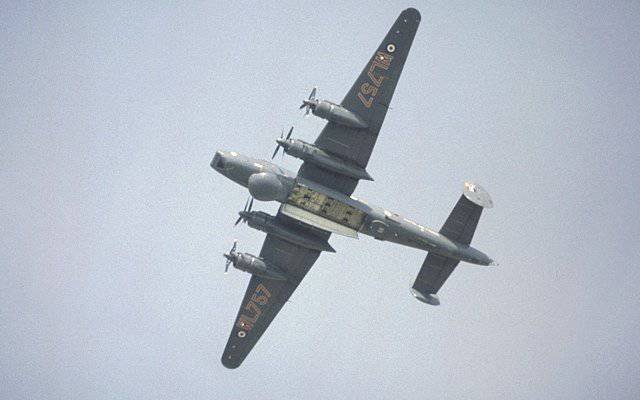
In fact, in the UK, at the end of 1960, a study was begun on the possibility of building a base DRLO aircraft; in 1977, the final decision was made that the base for it would be BAe Nimrod, the anti-submarine version of the Kometa passenger. The issue with the radar was more difficult to solve - various options were offered both for installing American systems and developing our own. In order to support the domestic manufacturer, they stopped at their own development: two Marconi scanning locators had to be placed in the nose and tail of the aircraft. Other e-stuffing, including computers, should also have been British-made. The government was not interested in the question of whether the desired result was achievable with the current state of industry - for the Labor Party, the preservation of jobs was more important ...
More Laborites love to save - and began to write off deck "Gannets". This did not eliminate the need to have DRLO planes in the Air Force, and in 1972, they adopted the Shakleton AEW.2. This combination of the archaic four-engined piston patrol aircraft and the AN / APG-20 radar removed from the deck of the Gannets may have been cheap (especially since long-distance reconnaissance intelligence was largely out of business), but otherwise there was horror, especially for pilots. The fuselage was leaky, unheated, with insufficient sound insulation - a real nightmare. And it would be for that to suffer: in terms of combat characteristics, the plane was pretty much lower than even the out-of-date 1970's “Waring Star” to the top and the Soviet Tu-126. But I had to endure, hoping for the imminent emergence of new ultra-modern jet aircraft.
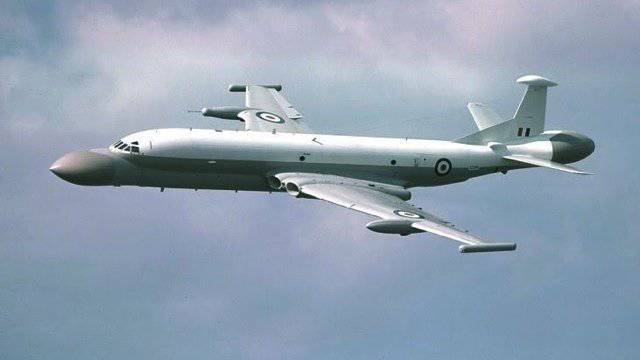
In 1977, the flights of the modified “Comet” began with a piece of equipment for the future DRLO aircraft, in 1980 the first flight of the experienced Nimrod took place, and in 1982 the serial Nimrod AEW.3 appeared. But…
In total, three prototypes and eight serial Nimrod AEW.3 were built, they even went into service in 1984, but they were not able to bring the electronic stuffing to serviceability. In the end, the program, which cost the taxpayers nearly 1.4 a billion pounds, was canceled in 1986 in the year, and American E-2D Sentry was ordered instead of Nimrod.
The other British AWACS aircraft, the AEW Defender, also failed. This was a prompt response to the abandonment of the Nimrodov: this time, instead of a fancy and expensive aircraft, a small and cheap one was offered. The base for the Defender was the Britten-Nomad BN-2T Islander twin-engine nine-passenger passenger, a plane with good take-off and landing characteristics, a turboprop, but with a non-retractable landing gear. In the nose, where the baggage compartments used to be located, the Torn EMI Skymaster pulse-Doppler radar was installed in a hefty fairing, and, oddly enough, this did not really affect the flight characteristics. But the characteristics of the radar were not very high, as the fuselage, where two pilots and two operators were located, partially obscured his view, so that the allocation of air targets in the upper hemisphere was possible only in the 280 degree sector.
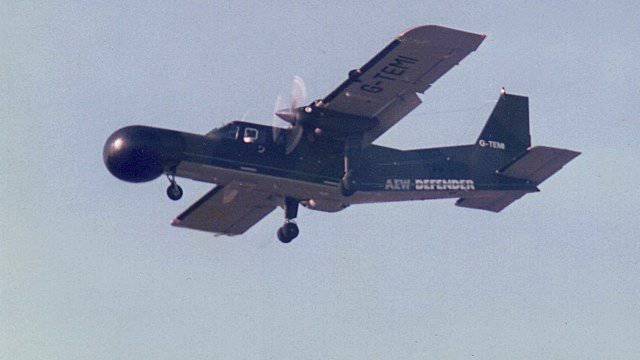
In general, the plane turned out somewhere at the Gannet level, but they already had a competitor in their forces - Sea King AEW helicopters. Although the Skymaster was slightly better than the Searchwater helicopter, and the Defender patrol duration reached as much as 9 hours (in reload version) - but the helicopters could be based on Royal ships fleet! There were no foreign customers for this dwarf either, and the aircraft remained in a single copy.
And while the trial and the case, the operation of the Shackleton continued, the last of the 12 machines of this type lasted until 1991! Not bad for an airplane and radar developed in the late 1940s, but hardly good for perhaps the most powerful aviation industry in the world ...
SAAB 100B Argus
The Swedes managed what the English failed. In general, the aviation industry of this country causes deep respect - with small defense expenditures, the Swedes manage to provide themselves with modern combat aircraft (and even export them). And with electronics they have everything in order. And, most importantly, ambitions are not excessive.
In the middle of 1980, Ericson began developing a PS-890 Erieye phased-array radar with a range of air and sea targets in 350 kilometers. The equipment provides almost the same capabilities as the American MESA, but the Swedish product was the first in the world in its class!
In order to refine the Erieye in 1987, the company was installed on Fairchild Metro III, but the S-100B Argus became the Swedish serial airborne patrol, in which the modification of the native 33-passenger SAAB SF340B Cityliner (developed jointly by Fairchild and SAAB) was the carrier. The first combat aircraft was ready in 1994.
The radar on it, as well as on the Metro, is placed in a board-shaped fairing raised on racks above the fuselage, but in order to reduce its drag, it was decided not to put elements for review in the front and rear hemisphere. Because of this full circular view, the antenna does not provide - although targets can be detected in any direction, they can be followed only in sectors along 150 degrees on the sides. However, this disadvantage can be compensated for by choosing a patrol path, and to correct the deterioration in road stability caused by the installation of the radar, rather large aerodynamic ridges appeared under the tail of the aircraft, and vortex generators appeared on the wing and stabilizer, improving the flow.
"Argus" is a purely Swedish product, focused primarily on the specific needs of the country's air defense. In Sweden, StriC-90, a state-of-the-art ground-based air defense control system, was deployed, and the Argus should have smoothly incorporated into the role of “high-lying” radar posts. Because of this, the crew consists of only three people - two pilots and a radar specialist. On this latter lies the entire responsibility for the operation of the locator, the real control of which is carried out from the ground, the data on the goals and other things are automatically transferred there too. The fighter is also guided by ground control centers, where the data on the air situation from ground locators, DRLO planes and Grippen fighters flow and where they are processed. So to some extent this is a return to the days of TBM-3W, but at a new technological level.
Probably, the absence of operators and associated equipment has significantly reduced the cost of the Argus, but just in case there is an opportunity to install up to three operator places on board, although most of the control functions in this case are left to the ground services.
In total, the Swedish Air Force had ordered six aircraft, but even then the famous Scandinavian practicality had an effect. Radars were installed on four “Argus”, and on the other two they provided only the possibility of operational (reportedly within 24 hours) installation of “Eryay” “for the future”. Thus, if something happens to one of the radar-bearers, it will be possible to promptly provide him with a replacement, but for the time being, the BBC is operated by the Air Force as transport — conveniently!
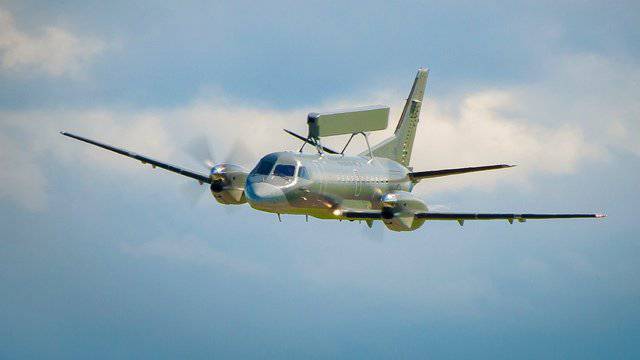
Argus for export
However, no matter how well adapted the Argus was for specific Swedish needs, it was necessary to try to sell the expansive costly DRLO system. Those interested were found, but here the narrow specialization of the masterpiece of the Scandinavian aircraft industry made itself felt: in other countries they wanted a full-fledged aircraft with the ability to control aircraft from the aircraft, and not from the ground.
In some cases, it was necessary to sell radars separately, which was still very profitable, since the electronic filling in such aircraft costs several times more expensive than the carrier. Yes, and the mass production of passenger aircraft SAAB was ready to roll ...
And yet, the "purely Swedish" Arguses got into other air forces. From 2000 to 2004 for a year, two cars flew with the designations of the Greek Air Force - while, however, listed on the balance sheet of the Swedish armed forces. The aircraft were issued for temporary use to the Greeks in order to get used to work with the “Erie” before entering into service with other aircraft with the same locator (more on them later). Before the transfer to the Greeks, the equipment of the Argus was noticeably modified, part of the Swedish equipment was removed from them and NATO was installed, since the open architecture of the machine allowed it. Two-three full-fledged operator consoles appeared on SAAB “on a permanent basis”, which after the return of the planes to Sweden decided not to dismantle. The Scandinavians decided that in this configuration "Argus" can be useful for use in various international events that are not related to the Swedish air defense.
The second foreign user of the Argus, this time on an ongoing basis, was Thailand. As part of the military cooperation program in 2008, this country ordered a batch of aviation equipment, which, in addition to the Grippen fighters, included two SAAB 340 - one transport, and the second AEW. Thus, Thailand "Argus" went as an integral component of a unified air defense system, which includes fighters and ground posts with the appropriate equipment. Apparently, the equipment of these aircraft is close to the "Greek" machines.
Both Saabs were received by the Thais at the end of 2010 of the year, and a little earlier they signed another large package of contracts, in which there was another Argus, which entered the country in October of 2012 of the year.
And 2009 was awarded a contract for the supply of two Argus to the United Arab Emirates - a good salesmanship for a specific Swedish product!
SAAB 2000 Erieye
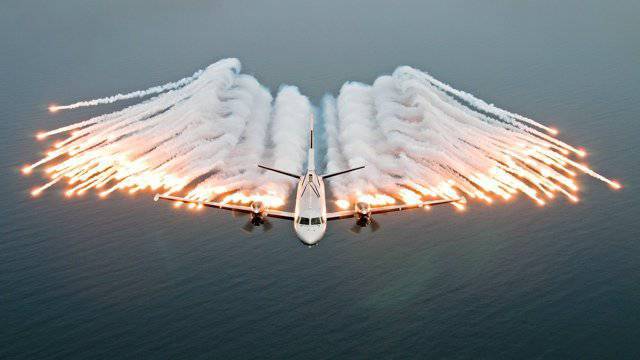
In the meantime, the Swedes began to think about changing the carrier for their Eriaevs. It would be logical to put them on large-sized SAAB 2000 (also no longer available, but available in a significant number), but so far no decision has been made. But a bunch of SAAB 2000-Erieye ordered Pakistan. The contract for the supply of seven aircraft was signed in 2006 year, later adjusted downward to 5 machines, the first was transferred to Pakistanis at the end of 2009 year, the second - in April 2010 year. As in Sweden, not all aircraft. and only 4 carry radar, the fifth is a backup in case of problems with one of the combat. Each plane is equipped with jobs for five operators.
Embraer R-99A Erieye
But even SAAB 2000 is not everyone likes - but you can only buy radar! The first in 1997, Erieye was acquired by Brazil. The country decided to stop the chaos that was happening on the vast and in fact uncontrolled expanses of the Amazon, providing its air force with specialized patrol aircraft and AWACS aircraft under the program SIVAM. There were no problems with carrier - Embraer is just releasing a suitable ERJ-145. It is more and faster than Saab, and the aircraft based on it called R-99A was originally planned as a full-fledged DRLO aircraft with the ability to control air combat and other things.
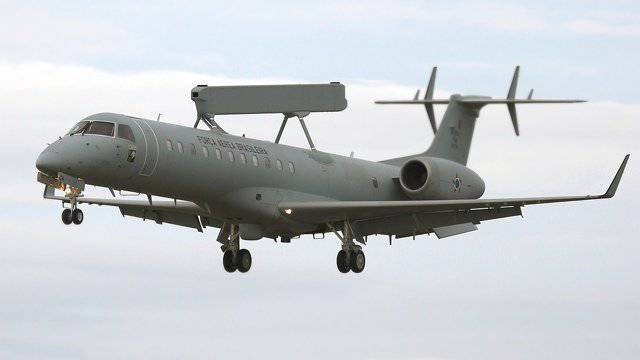
The first flight of the R-99A took place in the 1999 year, the first of the five ordered aircraft entered service with the Brazilian Air Force in the 2002 year, the last in the 2003-m. From the original airliner, the R-99A differs by the presence of a radar antenna over the fuselage and additional vertical keels on the horizontal tail and under the tail section of the fuselage. A typical crew consists of five people - two pilots and three operators, but there are places on board for the second camera shift. There is no refueling equipment on the R-99A, but the capacity of the fuel tanks on it is increased compared to the passenger version.
At the end of 2003, the first of the four R-1999A ordered in 99, was received before by the Greeks who had been training at Argus, by the middle of 2005, their order was completed. At this point (in the 2004 year) another export R-99A was manufactured, this time for Mexico, which decided to supplement Embraermi with its “anti-narcotic” fleet “Hokaev”. At the same time, Mexicans purchased the ERJ-145 patrol version, known as the P-99, and these Embraery work in conjunction with the R-99 that remains in a single copy like the American Orion customs.
Embraer R-99A DRDO
The fourth customer of R-99A (in 2008, re-designated in the Brazilian Air Force in E-99) was India, but nothing came of the deal to the Swedes. After all, the Indians have chosen the Brazilian aircraft as the carrier for their own phased-array radar, developed by the Defense Research and Development Organization (DRDO). The radar is not ready yet, its real characteristics are unknown, but, apparently, will be close to the Swedish “Eriay”, as well as the layout and dimensions of the antenna.
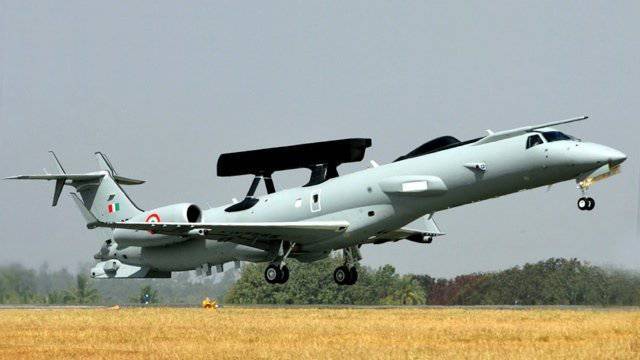
India’s desire to develop its own locator for the DRLO aircraft was not born yesterday. Back in 1985, the Project Guardian (later renamed Airawat) was launched, under which DRDO (with the assistance of the Israeli Elbit) created a radar intended for installation on the IL-76. The rotating locator antenna was to be placed, as on the A-50, in a plate with a 7.3 diameter meter raised above the fuselage on the pylon, but to save the Indians decided to highlight the British aircraft Hawker Siddeley HS.748 Andover, produced in India under a license like HAL-748. Said and done: the first flight of the HS.748 AEW took place in 1990, the first was followed by two more of the same aircraft.
It cannot be said that the choice was successful: the twin-engine turboprop aircraft was much smaller than the IL-76, and the presence of a high keel on it made it necessary to place the radar plate on an even higher pylon. The experiments ended badly - in 1999, one plane crashed, and it was reported that the crash was partly caused by excessive loads on the structure and deterioration of controllability after installing the radar. As a result, the program was terminated, and the Indians decided to purchase A-50 with Israeli radars. In addition to them, R-99 was chosen, more precisely EMB-145, since Indian order planes differ markedly from the Brazilian counterpart. And not only by a radar: the aircraft has a satellite communication system (antenna in a blister on top of the fuselage), an air refueling system and other things.
The first aircraft was flown at the end of 2011, but without a significant part of the equipment, which is expected to be installed in the first half of this year, and flight tests will begin before the end of the year. A total of three aircraft have been ordered, but perhaps these are only the first signs - India needs two dozen cars of this class, and it is not yet possible to develop its own carrier.
Boeing EB-707 Condor
Israel did not have its own carrier either, but this did not prevent it at the end of the 1980-s in parallel with the Swedes to develop a phased-array radar suitable for installation on an aircraft. As part of the IAI at ELTA Electronics, they were able to create the EL / M-2075 Phalcon radar, which in many aspects surpasses even similar American designs. The detection range of air reaches 350 kilometers (according to other data - to 500), and this is quite enough for a tactical DRLO aircraft, which Israel wanted to receive instead of the imperial "Hokaev".
However, the Israelis began with the "not quite tactical" Boeing 707. Unlike the US E-3, on the same base, the aircraft converted by IAI (known as EB-707) looked different. Instead of a pancake over the fuselage, huge panels of side-view antennas appeared on the sides, and the front and rear sectors looked at antennas in a voluminous, hanging down nose nose fairing. After that, the Boeing looks a bit strange, but its radar system provides all-round visibility.
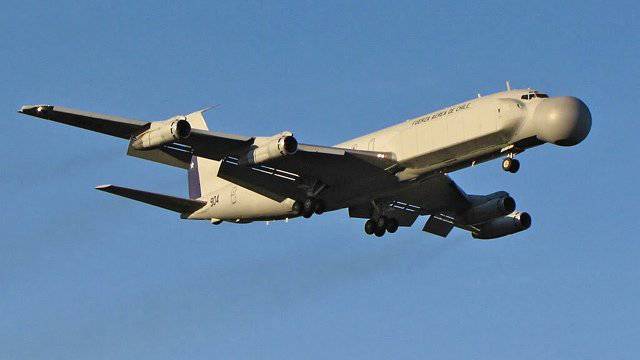
Work on EB-707 began in 1990 and. which is typical, it was created exclusively for export: the only car was converted from an aircraft previously owned by the airline LanChile, and transferred to the Chilean Air Force in 1995 year. The device was named Condor and still flies, albeit in a single copy.
Ilyushin-Beriev A-50I / EI
Showing on the example of the "Condor" that the Falcon really works, the Israelis began to throw fishing rods on the subject of selling their product with the installation of hardly any type of aircraft. As it is easy to guess, “poklevki” in the first place went on the part of states that have difficulties in relations with the United States.
The first was China, for which in 1997, the Israelis contracted to make an ARLO aircraft, united with Russia, which supplied the carrier, А-50. In Russia, the carrier was named A-50I, in 1999, it arrived in Israel, where the EL / W-2090 radar was installed on it. It was also placed in a “pancake”, but of a larger (12 m) diameter. It did not rotate, but inside it stood a “triangle” three antennas “Falcon”, which provided a circular view. The tests of the system were quite successful, but in 2001, under pressure from the United States, Israel was forced to terminate the contract.
But with India everything turned out. In 2004, the Israelis agreed with the Indians on the sale of three Falcon systems EL / M-2090, and the Indians and Russia on the purchase of three A-50 without the “stuffing”. In Russia, this was filed as a commercial success, but the Indians, like the Chinese, refused to accept the domestic radar, even though in the 2000 year the A-50 fully equipped kit was leased to the Indian Air Force. The attempt to link the delivery of aircraft with purchases and the Bumblebee radar caused active displeasure of the Indians, who threatened that they could order the carrier for Falcon in Europe, on the basis of A310 (Airbus has long been offering its radar machines). I had to put up with ...
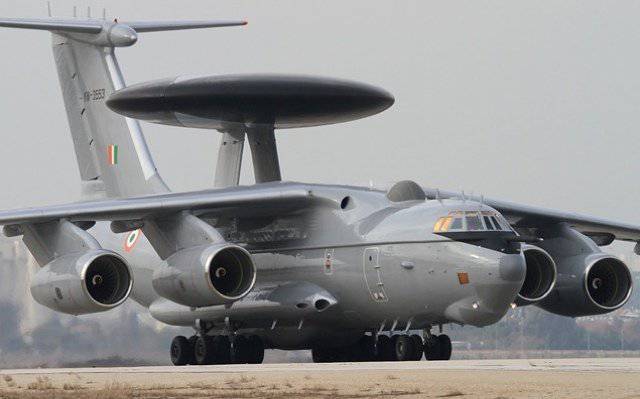
The planes were not built in Russia, but in Tashkent, with their delivery there was a big delay, and the first A-50EI, arriving from Israel, was met in India only at the end of May 2009 of the year. The “Indian” differs from the Russian A-50 not only with radar equipment (by the way, compared to the Chinese car, the antennas could fit on it in a “dish” with a diameter of just 11 meters), but also with engines: instead of D-30, there are more advanced PS- 90. Currently, there are two airplanes in India, the third continues to be tested in Israel, because, at the request of the buyer, more new electronic equipment was installed on it.
In 2010, India expressed its intention to buy two more carriers in Russia, but the negotiations on this issue, it seems, have not ended with anything concrete.
IAI Eitam
And the Israelis, having filled their hands on large planes, matured to adapt the Falcon to a small tactical aircraft for the needs of their own Air Force to replace the American Hokaev. The base for the car, called the Eitam, was the business jet of the Gulfstream G550 - and this is not surprising, since the IAI has close ties with the Gulf Stream. The once elegant car was decorated with huge fairings around the sides, in which the antennas of the EL / W-2085 complex, the latest version of the Falcon, were hidden. Additional antennas are placed in the nose and tail skirts, which gives the radar a full all-round view.
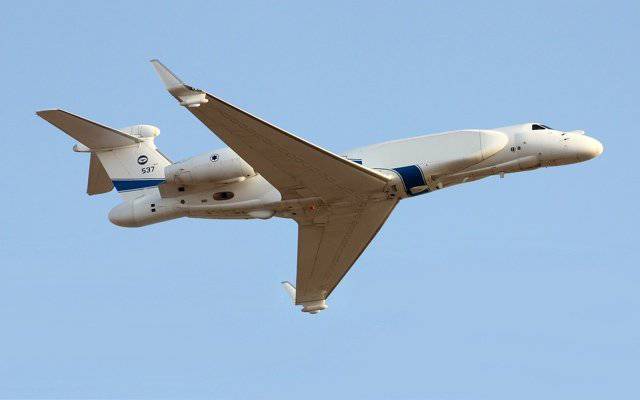
The first Aitam entered service with the Israeli Air Force in 2008, now there are five aircraft, some of which have a modernized radar system.
As soon as it appeared, Aitam attracted the attention of foreign customers. In 2007, Singapore placed an order for four aircraft, the first of which, taken from the Israeli Air Force, was handed over to the customer already in 2008.
The price of Eytam is about 350-375 million dollars apiece, which is very expensive - for comparison, the Argus is worth about 110 million. But sometimes it’s not about the money - and this seems to be the case with the acquisition of Eitams by Italy. The country has long been choosing the DRLO plane, but after Israel chose the Italian M-346 as the future training plane, the Italians need to answer something with a partner. It is reported that a contract will be signed for two "Eytam" - but so far no decision has been made.
Saddam’s Eyes: Baghdad-1 and Adnan
One of the main enemies of Israel. Iraq, also at one time tried to get an ARL aircraft. Although it happened before the capture of Kuwait, Hussein knew that the Americans of the AWACS system would not sell him, and in the USSR, with which Iraq had very warm relations, there were no such people for sale. Moreover, in Iraq there was neither a carrier, nor a radar, nor a technical capability to develop one or the other. But if you really want ...
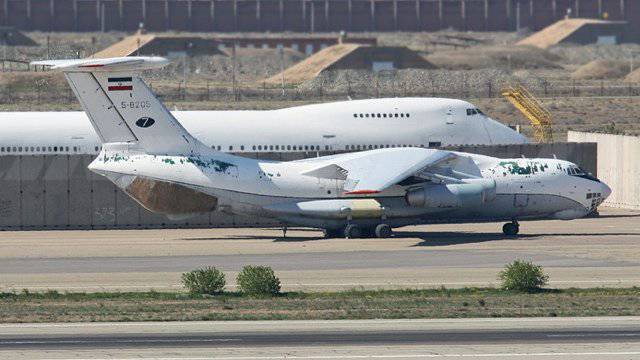
It was decided to blind the air command post from what it was. There were IL-76MD vehicles delivered by the USSR and French Thompson-CSF "Tiger-G" ground-based radars produced under a license like Salahuddin G. Thompson-CSF was chosen as an integrator of the project, equipment of other foreign companies was included in the aircraft equipment, for example Rockwell-Collins, Selenia and Marconi. The French did not particularly believe in the success of the project, but a machine called Baghdad-1 still appeared in the 1988 year. The antenna of the radar was mounted “top with legs” in a large fairing in the tail of the aircraft and, in theory, gave the detection range of air targets in 350 kilometers. But in fact, it turned out that it was impossible to simply put a radar on an airplane: a working locator heated the plane heavily, so after an hour and a half it was already impossible to be at the operator’s workplaces
But the Iraqis did not calm down, and made on the basis of the IL-76 another DRLO aircraft, called Adnan. Saladdin also stood on them, but its antenna was mounted in a pancake-like fairing, so it was very similar to the Soviet А-50. It was hardly possible that there was absolutely no help from the USSR, and the result seemed to be more acceptable: at least Adnans did three things.
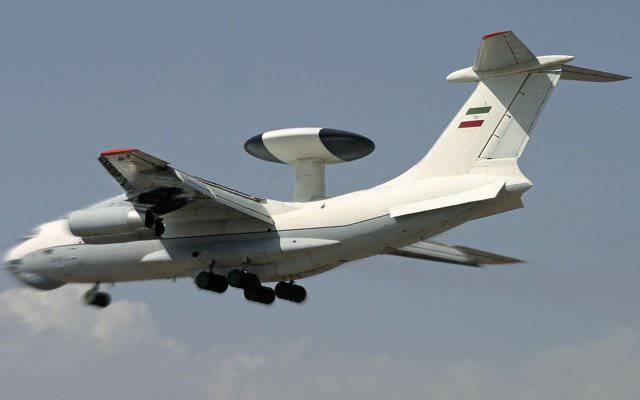
These aircraft did not bring benefit to Iraq: one Adnan was destroyed on earth by multinational forces during the Storm in the Desert, the rest and Baghdad flew to Iran, where they are still.
Iranians are currently rumored to be exploiting one Adnan, the second is being renovated and modernized. Attempts are being made in the country to create their own DRLO aircraft on the basis of the licensed An-140, but since no one can or does not want to sell such a radar to the Iranians, and they themselves cannot develop it either, this desire will remain so in the foreseeable future.
Xian KJ-1
But the program to develop airplanes in China is crazy pace, and the number of types in China is more than in any other country in the world. But here is how much Chinese in them - you can guess.
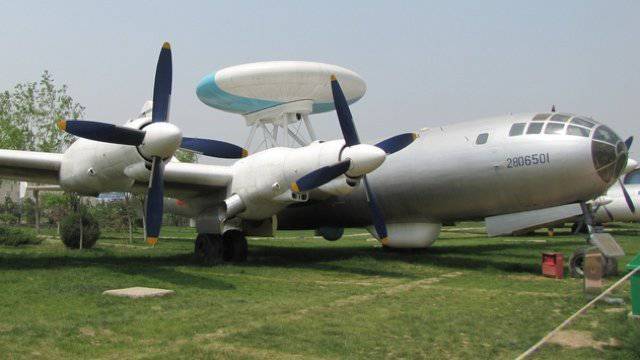
The first Chinese attempt to develop DRLO aircraft, back in 1960, ended with the construction of two Xian KJ-1 aircraft. The radar, located in the "plate" above the fuselage, was Soviet, and was located in it the radar "Liana", similar to that which stood on the Tu-126. And the carrier ... This one was “a copy of a copy with the addition of another copy”. It was called Xian AP-1, and was the turboprop version of the Soviet Tu-4, which, in turn, was the “front end” of the American B-29, and the engines were “stripped off” from the An-12. As onboard the AP-1, it was possible to place not only the radio-electronic equipment, but also the operators, it is not clear, but, apparently, with great difficulty, and the leadership of the Chinese Air Force had to admit that there was no great benefit in the KJ-1.
KJ-2000
The main problem in the development of KJ-1 was that no one sold modern aircraft of such purpose to China and equipment for them, because, as is known, the main driving force behind China’s progress is the import (legal and not) of foreign technologies. Further story DRLO aircraft gives this additional confirmation.
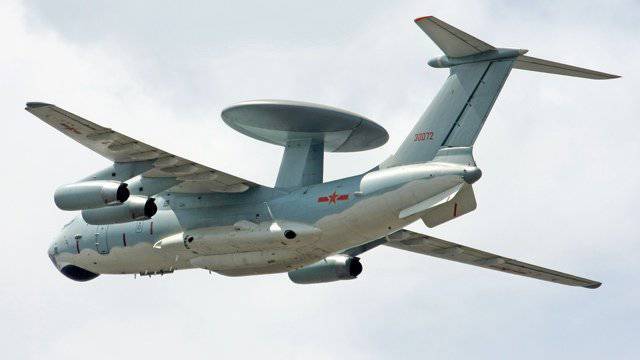
As soon as it became possible, China began negotiations with Russia on the acquisition of А-50 (as a completely modern carrier), and with the Israeli radar (the Soviet one was already “yesterday”). The program ended with the delivery in 2002 of the year of one aircraft without a radar, which became a model for such a refinement of conventional IL-76MD, in the middle of 1990-s delivered to China. Fortunately, the Chinese had little need for IL-76, and they didn’t organize their own carrier production. But a radar with a phased array they had appeared, not the Israeli front end, not the modification of the previously developed Chinese shipborne radar, but it was clearly not born from scratch.
Already in 2003, the first flight of the resulting KJ-2000 aircraft took place, 5 units were probably built by now. The Chinese need more, but they do not want to retool the IL-76 transport that they have left, and they are negotiating with Russia to acquire additional carriers.
Y-8AEW / KJ-200
The largest carrier produced in China is Y-8, a copy of An-12. The first attempt to turn it into an ARLO aircraft goes back to 1996, when the Chinese bought eight Skymaster 1970 radars (the same that were on the AEW Defender) in England. The radars were installed in the nose Y-8, turning them into Y-8J, aka Y-8AEW. It turned out better than with the Defender, since there is enough space onboard a four-motor transporter for electronics, crew and fuel, so the plane can hang in the air for up to 11 hours.
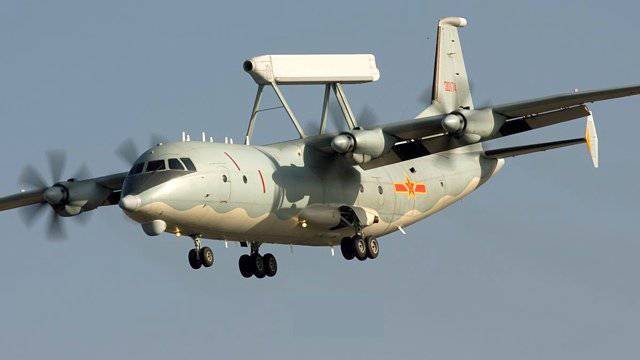
The first two aircraft entered service by 2002, but work was already underway on a more advanced modification - the KJ-200. This time, the radar installation completely copied the Swedish Erieye, (perhaps there is also an analogue of this product inside), but there are additional antennas in the nose and tail, so that, probably, a full all-round view is provided. The first flight of the prototype took place in 2001, the base was a Y-8F-600 powered by Pratt & Whitney Canada PW150B engines and Honeywell avionics. They say that these machines should, together with the KJ-2000, form a single system in which the KJ-200 will act as advanced radar pickets, and on board the KJ-2000 information will be processed and controlled.
The exact number of aircraft produced is unknown, but China has already begun production of DRLO aircraft for export. The first customer was, as you might guess, Pakistan, which ordered four ZDK-03 aircraft in China for just 278 million dollars. The carrier here is the same Y-8F600, but this time the antenna is placed in the “pancake” above the aircraft fuselage. What is there for the radar and what are its characteristics, not reported, but it seems to be also a phased-array device, a smaller version of what is on the KJ-2000.
The Pakistanis received the first aircraft already at the end of 2010 of the year, the second at the end of 2011 of the year. It is difficult to say whether there will be more customers for Chinese airplanes, after all, the thing is quite expensive. But the fact itself suggests that nowadays almost any country that has money and desire can acquire DRLO aircraft. But progress does not stand still - in the same States, very special carriers and very specific radars are already being developed ...
Information